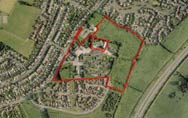
Not a village and not eco enough
The builder of Britain�s first carbon-neutral �village� has been selected by the Government.
English Partnerships, the land quango, and Housing Minister Yvette Cooper have chosen Barratts to build the 200 homes in a converted hospital building and grounds. As this aerial view shows, its unfortunately close to a fast road, which will at least keep the prices down. (part of the government’s aim is that the homes should be affordable) It is anticipated that the site will have retail floor space and employment space. An onsite biomass CHP plant will deliver energy to all homes.
The aim is to build 200 super-energy-efficient houses about six years ahead of the Government�s deadline for ensuring that all new housing is carbon-neutral. But the majority of the �houses� may in fact be flats. It is unclear what will happen to the Grade 2 listed hospital, but its hardly likely to be a showcase for the cutting edge of energy-efficient building techniques. On the other hand, its better than knocking the place down.
But calling it the development a �village� is stretching things a bit. As the aerial view shows, its a pleasant piece of land bounded on three sides by streets full of semi-detached houses, and on the fourth side by the road. Presumably the new eco-residents will not be commuters driving into Bristol every day,once they arrive in a few years time?
The cost of making a typical home carbon-neutral in the Bristol area could add between 10 per cent and 20 per cent to the total build costs per plot, according to one chief executive of a housebuilding company who has examined the scheme.
�The extra cost could be �20,000 to �30,000 per plot. So, say for 150 homes, that is an extra �4.5 million. That may need to be subsidised in the sale. I don�t think English Partnerships will want to discount the sales price either,� he said.
The building companies were already wingeing about the huge extra cost of building ecologically sound homes, costs partly associasted with the need to re-educate their workforces. Barratt Developments and Taylor Wimpey, Britain�s two largest builders, were vying for the contract, along with MJ Gleeson, a rival quoted builder; Edward Ware, a private firm; and Places For People, a housing association.
The scheme will provide a bench-mark for both the Government and the housing industry to calculate how much of the higher costs associated with so-called eco-housing can be passed on to homebuyers.
All new homes built from 2016 must be carbon-neutral, according to new rules issued in March.
The minister also unveiled the six shortlisted bidders for the second Carbon Challenge site – South Bank Phase 1, in Peterborough; and two new sites in the North of England.
The shortlisted developers for South Bank Phase 1 are:
* One Peterborough (a consortium of Crest Nicholson and Bioregional)
* Gladedale Group
* Carbon Challenge Consortium (Galliford Try and Cross Key Homes)
* Barratt Homes Ltd
* P Pod (Morris Homes and Gentoo)
* Gleeson Homes and Stuart Milne Group
The shortlisted developers will now be invited to submit a more detailed response to achieve Level 6 of the Code, by achieving zero carbon, incorporating features to reduce water usage and energy consumption, minimising waste, and increasing biodiversity. A decision on the final preferred developer at South Bank Phase 1 is expected early next year.
The two new Carbon Challenge sites announced today are both in former coalfield communities, devastated by pit closures in the 1980s – Brodsworth Colliery in Doncaster and Bickershaw Colliery in Wigan.
Expressions of interest in both sites will be invited via OJEU in January.
Housing sources said Barratts may build the homes as a loss-leader, absorbing the extra costs of installing energy-efficient devices as a marketing tool for what is expected to be a booming sector in five or six years� time.
The Government has also promised to free up swaths of state-owned land over the coming years to ensure that the country can raise its annual housing output to about 225,000 new homes a year, up from the 180,000 currently built each year.
But much of that new land is likely to be sold only to housebuilders that can prove their green credentials and guarantee to build carbon-neutral homes.
Barratt has built its own eco-street of seven houses in Chorley, Lancashire, to try to gauge both the cost of building energy-efficient homes and the energy savings they will produce.
Land in the Bristol area is selling for between �80,000 and �90,000 per unit.
Ralph Hawkins, Barratt development director, said: �Barratt is extremely keen to deliver this development, not least because we have outstanding experience of implementing green technologies at our eco-village in Chorley.�